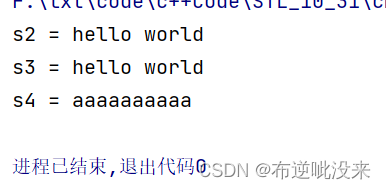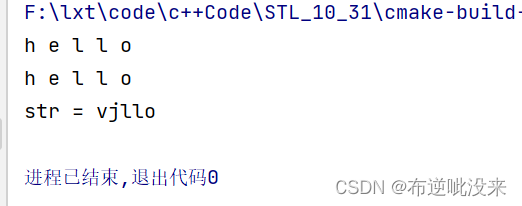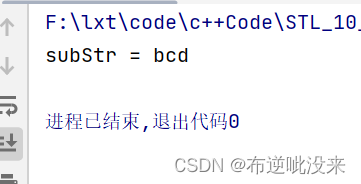STL常用容器
3.1 string容器
3.1.1 string基本概念
本质:
string是C++风格的字符串,string本质上是一个类string和char * 区别:
char*是一个指针string是一个类,类内部封装了char*,管理这个字符串,是一个char*型的容器。特点:
string类内部封装了很多成员方法 例如:查找find,拷贝copy,删除delete,替换replace,插入insertstring管理char*所分配的内存,不用担心复制越界和取值越界等,由类内部进行负责
3.1.2 string 构造函数
构造函数原型:
string();//创建一个空的字符串 例如:string str;string(const char* s);//使用字符串s初始化string(const string& str);//使用一个string对象初始化另一个string对象string(int n; char c);//使用n个字符c初始化
示例代码:
#include <iostream>
#include <string>
using namespace std;
//string 的构造函数
void test01(){
string s1; //默认构造
const char* str = "hello world";
string s2(str);
cout << "s2 = " << s2 << endl;
string s3(s2);
cout << "s3 = " << s3 << endl;
string s4(10, 'a');
cout << "s4 = " << s4 << endl;
}
int main(){
test01();
return 0;
}
运行结果:

3.1.3 string赋值操作
功能描述:给string字符串进行赋值
赋值的函数原型:
- string& operator=(const char* s); //char*类型字符串 赋值给当前的字符串
- string& operator=(const string &s); //把字符串s赋给当前字符串
- string& operator=(char c); //把字符c赋值给当前的字符串
- string& assign=(const char* s); //把字符串s赋给当前字符串
- string& assign=(const char* s, int n); //把字符串s的前n个字符赋给当前字符串
- string& assign=(const string &s); //把字符串s赋给当前字符串
- string& assign=(int n, char c); //用n个字符c赋给当前字符串
#include <iostream>
#include <string>
using namespace std;
//string赋值操作
void test01(){
//string& operator=(const char* s); //char*类型字符串 赋值给当前的字符串
string str1;
str1 = "hello world";
cout << "str1 = " << str1 << endl;
//string& operator=(const string &s); //把字符串s赋给当前字符串
string str2;
str2 = str1;
//string& operator=(char c); //把字符c赋值给当前的字符串
string str3;
str3 = 'a';
//string& assign=(const char* s); //把字符串s赋给当前字符串
string str4;
str4.assign("hello C++");
//string& assign=(const char* s, int n); //把字符串s的前n个字符赋给当前字符串
string str5;
str5.assign("hello C++", 5);
//string& assign=(const string &s); //把字符串s赋给当前字符串
string str6;
str6.assign(str5);
//
string str7;
str7.assign(10, "r");
}
int main(){
test01();
return 0;
}
- 总结:
string的赋值方式很多,operator=这种方式是比较实用的
3.1.4 string字符串拼接
功能描述:实现在字符串末尾拼接字符串
函数原型:
- string& operator+=(const char* s); //重载+=操作符
- string& operator+=(const char c); //重载+=操作符
- string& operator+=(const string &str); //重载+=操作符
- string& append(const char* s); //把字符串s连接到当前字符串结尾
- string& append(const char* s, int n); //把字符串s的前n个字符连接到当前字符串结尾
- string& append(const string &s); //同operator+=(const string &str);
- string& append(const string &s, int pos, int n); //字符串s中从pos开始的n个字符连接到字符串结尾
- 示例代码略
3.1.5 string查找和替换
- 功能描述:
- 查找:查找指定字符串是否存在
- 替换:在指定的位置替换字符串
函数原型:
int find(const string& str, int pos = 0) const; //查找str第一次出现位置,从pos开始查找
int find(const char* s, int pos = 8) const; //查找s第一次出现位置,从pos开始查找
int find(const char* s, int pos,int n) const; //从pos位置查找s的前n个字符第—次位置
int find(const char c, int pos = 0) const; //查找字符c第一次出现位置
int rfind(const string& str, int pos = npos ) const;//查找str最后一次出现位置,从pos开始查找
int rfind( const char* s, int pos = npos) const;//查找s最后一次出现位置,从pos开始查找
int rfind(const char* s, int pos,int n) const; //从pos查找s的前n个字符最后一次位置
int rfind(const char c, int pos = 0) const;//查找字符c最后一次出现位置
string& replace(int pos, int n, const string& str); //替换从pos开始n个字符为字符串str
string& replace(int pos, int n,const char* s ) ; //替换从pos开始的n个字符为字符串s
其中find返回值为int类型的值,若查找失败返回-1
find和rfind区别:rfind从右往左查找,find从左往右查找。因此若查找的字符串中所查找字符出现多次时二者返回值不同。
3.1.6 string字符串比较
功能描述:
- 字符串之间的比较
比较方式:
- 字符串比较是按字符的ASCII码进行对比
=返回 0
>返回 1
<返回 -1函数原型:
int compare(const string &s) const; //与字符串s比较
int compare(const char *s) const; //与字符串s比较
字符串对比主要是用于比较两个字符串是否相等,判断谁大谁小的意义并不是很大
3.1.7 string字符存取
string中单个字符存取方式有两种:
char& operator[](int n);//通过[]方式取字符char& at(int n);//通过at方法获取字符
代码示例:
#include <iostream>
#include <string>
using namespace std;
//string 字符存取
void test01(){
string str = "hello";
//1. 通过[]访问单个字符
for(int i = 0; i < str.size(); i++){
cout << str[i] << " ";
}
cout << endl;
//2. 通过at方式访问单个字符
for(int i = 0; i < str.size(); i++){
cout << str.at(i) << " ";
}
cout << endl;
//修改
str[0] = 'v';
str.at(1) = 'j';
cout << "str = " << str << endl;
}
int main(){
test01();
return 0;
}
运行结果:

3.1.8 string插入和删除
功能描述:
- 对string字符串进行插入和删除字符操作
函数原型:
- string& insert(int pos, const char* s); //插入字符串
- string& insert(int pos, const string& str); //插入字符串
- string& insert(int pos, int n, char c); //在指定位置插入n个字符c
- string& erase(int pos, int n = npos); //删除从pos开始的n个字符
插入和删除的起始下标都是0。
3.1.9 string子串
功能描述:
- 从字符串中获取想要的子串
函数原型:
string substr(int pos = 0, int n = npos) consts;//返回由pos开始的n个字符组成的字符串。
代码示例:
void test02(){
string str = "abcdef";
string subStr = str.substr(1, 3);
cout << "subStr = " << subStr << endl;
}
运行结果:

该功能实用性高。例如从邮箱地址中获取用户名信息
代码示例:
void test03(){
string email = "lbb@163.com";
//从邮箱中获取用户信息
int pos = email.find("@"); //3
string userName = email.substr(0, pos);
cout << "userName: " << userName << endl;
}
运行结果:






















 3015
3015











 被折叠的 条评论
为什么被折叠?
被折叠的 条评论
为什么被折叠?








